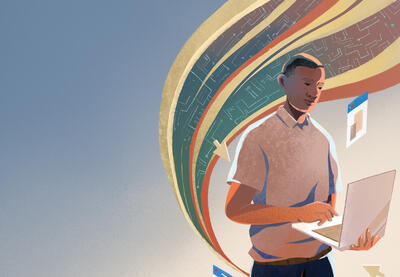Every crisis and injustice now live in two parallel realities: on the ground and online.
Misinformation and online conspiracy theories had detrimental effects on mitigating the COVID-19 pandemic. Dehumanizing online rhetoric and anti-Asian misinformation surrounding the coronavirus often amplified and inspired offline violence. Online disinformation campaigns targeted Black voters to suppress turnout. And years of disinformation helped foment an attempted insurrection of the U.S. Capitol building on January 6.
At every turn, online misinformation, misrepresentation and hate had direct ties to offline acts of violence and threats to democracy.
The scale is global. “Everywhere we look around the world, disinformation is a threat to society,” says Dr. Kristin Lord, president and CEO of IREX, a global development and education organization. “No matter what issue you look at, whether it’s violence and racism in the United States, polarization, health issues like the pandemic or the health of democracy—you can just go down a list and disinformation makes every public policy challenge harder.”
The scope of the challenge underscores the need to understand the roots of today’s online misinformation and hate—and how to counter them.
Experts say schools and communities need to update and extend their commitment to digital literacy* across all subject areas—in a way that directly addresses how information spreads, who it helps and who it harms.
What Isn’t Working
*SIDE NOTE
We use the term digital literacy to describe a holistic approach to cultivating skills that allow people to participate meaningfully in online communities, interpret the changing digital landscape, understand the relationships between systemic -isms and information, and unlock the power of digital tools for good. This includes media literacy. Terms like critical media literacy, media literacy, news literacy and more are not necessarily interchangeable.
The way media literacy is often taught has a simple objective: to help students discern a “good source” from a “bad source.” These lessons often fail to provide students with transferrable skills they need to navigate today’s online spaces.
Dr. Joel Breakstone directs the Stanford History Education Group (SHEG), whose Civic Online Reasoning (COR) curriculum translates skills learned from professional fact-checkers into classroom practice. He says, “One of the biggest challenges we’ve encountered is that so much of the existing materials focused around digital literacy are really outdated and can lead students dangerously astray.”
This includes checklists like the widely used “C.R.A.P. test,” which provides criteria for evaluating a source’s credibility. The criteria include things like credible URL domain names (.org, for example), which Breakstone explains can easily belong to a fake or biased source.
Curricula like COR focus instead on skills like lateral reading and click restraint that can help students evaluate any source, even if it externally presents as credible.
SHEG’s studies illustrate that these skills do make students better fact-checkers. But COR doesn’t stop there—and experts agree that it’s important to take digital literacy beyond the question of true or false.
“If we rely exclusively on a simple true-false measure of content, we lose out on the nuance,” says Dr. Alison Trope, the founder and director of Critical Media Project. “[We] potentially dilute or obfuscate the importance of unpacking and understanding the complexities of the media we consume, the ideologies they embody, and the way those ideologies are normalized and perpetuated in culture and society.”
Azsaneé Truss agrees. Truss is a doctoral student at the University of Pennsylvania, researching at the intersections of critical media studies, identity, justice and power structures. She sees traditional media literacy as failing to ask fundamental questions.
“It’s very focused on what’s real and what’s fake, what’s objective and what’s not,” Truss explains. “I think it should be more about moving toward, ‘Who made this? Why did they make it? What systems of power does this enforce? What perspective are they sharing? Whose stories are being told, and whose are being left out?”
Breakstone also notes that many traditional media literacy materials are not real-world examples or relevant to students—often in attempts to present “neutral” content.
“What we need to do is give students the opportunities to practice with the kinds of sources they encounter every day,” Breakstone says.
Peter Adams, the senior VP of education at the News Literacy Project, echoes this need. Those “authentic examples,” Adams says, “help students develop a deeper understanding of how misinformation works, the patterns it expresses over time and steps they can take to combat it.”

The Stakes for Students
Fostering those skills in students and their communities is essential to their well-being.
“As the disinformation scholar Joan Donovan has pointed out, the effects of disinformation and extremist propaganda are distributed rather than primarily borne by the people who create and amplify it,” Adams says.
Learning for Justice has tracked reported hate incidents that take place in school contexts. From 2019 to 2021, 35% of incidents happened online. Often, incidents intersected with surges in online misinformation, such as a spike of anti-Black incidents that coincided with concerted efforts to spread misinformation and fearmongering about Black protesters in June of 2020. Targeted students faced compounding harms.
It’s why “centering survivors and victims of hate … is incredibly important in these interventions,” says Wyatt Russell, a fellow for American University’s Polarization and Extremism Research Innovation Lab (PERIL). Their resources focus on combating youth radicalization and recruitment by extremists. “We can’t just be focusing on the perpetrator and their needs.”
But students are at risk of internalizing these harmful messages. Part of expanding digital literacy means providing students with skills and supports to inoculate them against extremist rhetoric and recruitment. This became especially pressing during a pandemic in which many students were isolated and very online.
With the Southern Poverty Law Center, PERIL produced a guide that offers strategies for recognizing signs of radicalization and intervening. The focus groups that informed the latest revision of the guide included educators, who stressed the need for digital literacy resources and restorative intervention strategies.
The consequences of inaction are dire.
“If no actions are taken, polarization can increase the potential for youth to continually be on-ramped,” Russell says. “These problems don’t go away, and that’s going to mean continual instances of hate and bias within our schools, within our communities.”
Media literacy is doomed to fail if it is a separate, standalone course.
— Dr. Joel Breakstone
What Students Need
Research indicates that students need repeated practice to develop sustainable digital literacy skills. The most seamless way to make this happen, experts say, is to teach digital literacy across all subject areas.
“Media literacy is doomed to fail if it is a separate, standalone course,” Breakstone says. “If it is a barnacle on the hull of a bloated curriculum, it’s going to be scraped off when there is a crisis or budget crunch.”
It’s also clear that for students to do better than the generations who came before them, they need to reckon with cognitive biases.
“This is actually very empowering,” Lord says. “When you understand how your cognitive biases work, when you understand why you’re reacting the way you do and why you were jumping to conclusions and why you have this urge to share certain things, it actually gives you back some control and power and helps you make different choices.”
These skills are important safeguards against online misinformation and hate speech. But conscious choices, historic harm and systemic prejudices can’t be ignored.
Building understanding, resilience and resistance to those threats requires directly confronting them.

Digital Literacy Is Social Justice
When the Confederate flag entered the Capitol building on January 6, it wasn’t carried by misinformation alone. It was hoisted by a belief that the wills of Black voters in Michigan and Georgia or Navajo voters in Arizona somehow counted less. Misinformation supported something more pervasive.
“Conspiracies and misinformation and disinformation played a huge role in what happened back in January,” Azsaneé Truss says. “But I think the thing that people are glossing over, again, is that the real issue here is white supremacy. These people were motivated by white supremacist propaganda.”
Trope is aligned in this thinking: “The issues have always been there because they are tied to unequal and unjust power structures that undergird our society and culture,” she says.
The insurrection exemplifies the importance of centering issues of identity and justice in teaching students to navigate misinformation.
Identity fundamentally Shapes our experience of the world.
— Dr. Alison Trope
But historically, explains Dr. Stephanie Flores-Koulish, media literacy has “avoided, in many ways, a social justice or critical media perspective.”
Flores-Koulish is the director of Loyola University’s Curriculum and Instruction for Social Justice program and the conference chair for the 2021 National Association for Media Literacy Education (NAMLE) Conference, which notably chose “Media Literacy + Social Justice” as its theme.
As a transracial adoptee, Flores-Koulish remembers searching for identity role models. When she didn’t find them in her community, she turned to television. “And they weren’t even there,” she remembers.
A more critical lens on digital literacy can help fill those voids in a meaningful way, Flores-Koulish says. She recently worked with a librarian who noticed multiple books in the library glorifying characters of color leaving home to enter predominately white spaces. The librarian questioned what implicit messages that storyline sent. It’s an example of the critical thinking that can create more affirming spaces. Flores-Koulish says it’s “an eye-opening experience for the kids themselves so that they will see there’s nothing ‘wrong with me’; it’s the way the messages and stories around me are telling me there’s something wrong with me.”
It gets right to the heart of work Trope and others do at Critical Media Project: “media literacy education that addresses not only misinformation but misrepresentation.”
Critical Media Project creates sequenced collections of media called “playlists,” for example, that offer students an opportunity to unpack how media narratives entrench stereotypes about identity groups, the power structures at play and how to disrupt those misrepresentations.
“Educators can’t change [the misrepresentations],” Flores-Koulish admits. But educators can help students see the systems behind them. “And then, it’s the educator’s responsibility to provide students with different representations, with more robust, vibrant portrayals of themselves.”
Centering identity and social justice gives students a fuller picture of how media and information operate.
“Identity fundamentally shapes our experience of the world,” Trope explains. “We also process information and perspectives based on the way our identities are presented to us. We, therefore, need to critically see and understand how identity is also a frame used by institutions to structure and deploy power. With that realization and using critical media literacy as a tool, we can not only see our own biases and how they shape our worldviews but also work to challenge structures of power and the way they collectively and individually shape us.”
Part of promoting that agency is allowing students to engage in media-making. Truss and Trope explain that media-making helps students understand how stories are made and equips them to critically engage with each step of the process, asking key questions about what was excluded and included. And it gives students tools for action.
“Your students have perspectives,” Truss says. “Your students are living in our society, and they have ideas about all this. I think they’re fully capable of unearthing all these systems of power and understanding them for themselves if we give them the space to do that.”
We don't see change unless people are demanding it.
— Erin McNeill
Advocating for a New Digital Literacy
Providing students that space will likely require coalitions of educators and caregivers advocating for its importance.
“There are steps, big and small, that educators can be taking,” says Erin McNeill.
McNeill is the founder of Media Literacy Now, a grassroots nonprofit advocating for policies that would make media literacy “an essential element in public education.” She started as a parent advocate.
McNeill says educators can make a big difference by educating caregivers on why media literacy is important. And if caregivers lean into learning more about media literacy and related resources, they can play a huge role in advocating for it to district leaders and school boards.
“We’re trying to get more of a grassroots army of people who understand what media literacy is, recognize its value and are asking for it,” McNeill says.
In a time when people opposing inclusive or robust education models are loud, local coalitions are vital to signaling support.
“It’s essential,” McNeill says. “We don’t see change unless people are demanding it.”
Despite the massive scale of the problem, experts say change is possible.
“It’s doable,” Lord says. She cites countries like Ukraine that have successfully integrated this work into schools and communities. Both IREX and Stanford’s COR point to data showing tangible improvements among those who learn the skills. It’s not a question of possibility, they say; it’s a question of scale.
“This is not some unsolvable problem,” Breakstone says. “What we need to do is to devote the resources, to take it on and to provide educators with the materials to do that effectively. ...
“It’s just a matter of if we have the will.”


